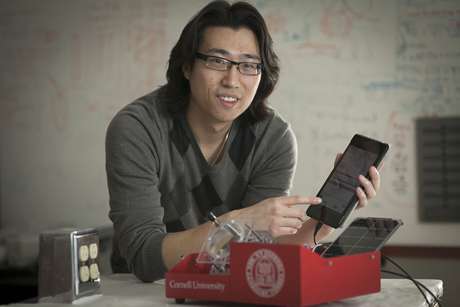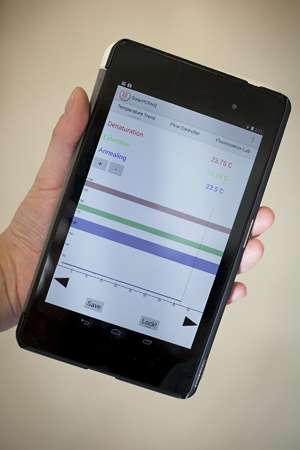Sun powers complex cancer test for remote regions

From the sun, a solution: Cornell University and Weill Cornell Medical College researchers have remodeled an energy-intensive medical test – designed to detect a deadly skin cancer related to HIV infections – to create a quick diagnostic assay perfect for remote regions of the world, according to Scientific Reports (Feb. 20), an online publication of Nature.
By harnessing the sun's power and employing a smartphone application, medical technicians may now handily administer reliable assays for Kaposi's sarcoma, which has produced significant morbidity and mortality rates among adults and children in sub-Saharan Africa.
This Cornell-developed solar thermal PCR (polymerase chain reaction) test for a smartphone uses about 80 milliwatts – or .08 watts – which means that a standard smartphone battery could provide about 70 hours of power for testing. With this system, medical technicians can obtain human skin biopsies, deposit the biopsied material into the solar thermal PCR device and obtain completed diagnostic tests with a smartphone in less than 30 minutes.
"Mortality in sub-Saharan Africa following a Kaposi's sarcoma diagnosis is unacceptably high, even after introduction of antiretroviral therapies. This is partly due to the difficulty of making an accurate diagnosis with current technologies, which results in delayed treatment and advanced disease, which is difficult to treat," said Ethel Cesarman, M.D., professor of pathology and laboratory medicine at Weill Cornell Medical College in New York.

"DNA tests are extensively used in medical diagnostics since they are sensitive and specific. Some places in the developing world have limited infrastructure and unreliable electricity, and these kinds of tests usually hog energy," said David Erickson, Cornell professor of mechanical and aerospace engineering.
"We believe that exploiting the ubiquity of solar thermal energy – as demonstrated here – could facilitate broad availability of nucleic-based diagnostics in resource-limited areas," said first author Li Jiang, a doctoral candidate in Cornell's Sibley School of Mechanical and Aerospace Engineering.
The thermal-cycling process needed for DNA amplification typically requires ample energy to process biopsies, including steps such as denaturation (breaking down nucleic acid structures), extension (duplicating the DNA chain) and annealing (recombining the DNA material). Solar thermal DNA amplification – which the Cornell group devised and that is the size of a lunchbox – removes the power requirements for thermal cycling and enables a 100-fold reduction in power consumption compared with state-of-the-art, Western devices.
"Tests can be performed in less than a half-hour, potentially enabling rapid diagnostics where long travel distances to clinics make follow-up meetings with patients difficult," said Cesarman.
Other authors of the study, "Solar Thermal Polymerase Chain Reaction for Smartphone-Assisted Molecular Diagnostics," include Matthew Mancuso, a doctoral candidate in Cornell's Department of Biomedical Engineering; Zhengda Lu, M.Eng. '13; and Gunkut Akar, a researcher in pathology and laboratory medicine at Weill Cornell Medical College.
Journal information: Scientific Reports , Nature
Provided by Cornell University


















